When University of Virginia neuroscientist Harald Sontheimer shared this year’s International Prize for Translational Neuroscience with Stanford’s Michelle Monje, publicity about the award created the impression of a partnership. The two were credited with the potentially life-saving and, thus, marketable discovery that gliomas—deadly brain tumors—wire themselves into neural networks, hijacking brain activity to fuel their own growth.
Sontheimer, who has experience moving advanced research into the commercial sphere, and Monje didn’t collaborate on the challenge, though. They arrived at their related conclusions from different directions as academic competitors racing toward the exciting new insights.
The convergence was a reminder that in brain research, and in all other areas of biological study, moving discoveries off the lab bench and into the real world starts with staking a big claim first, then capitalizing on it. In that regard, UVA’s brilliant minds are chasing breakthroughs in care that could save lives and redefine Virginia’s growing biotech landscape.
“We owe it to patients with this devastating disease to provide hope for innovative treatments,” Sontheimer said of gliomas.
But as entrepreneurs will attest, turning scientific innovation into impact requires more than knowledge—it demands knowhow, speed, and support, including massive financial and infrastructure investment.
And within academic institutions, where the stakes have never been higher, it apparently takes a willingness to think less like a university and more like a company.
A research diamond and developments in spades
UVA researcher Thomas Floyd, a doctor of anesthesiology specializing in heart and vasculature, says his move into translational research, with tech that can monitor blood flow to the brain, was motivated in part by personal loss and wanting to help others.
“It’s a bit of an emotional thing for me,” Floyd said. “Seventeen years ago my best friend died of massive head trauma.”
Floyd was among those who spoke passionately about the ups and downs of research translation at the August 26 meeting of CvilleBioHub, a biomedical entrepreneurial association that supports a cluster of more than five dozen Charlottesville-based biotech companies, many of them “spun out” from UVA.
Unlike in auto racing, spinning out is a good thing. And just like in any competition, our local minds have experienced thrilling successes and heart-rending setbacks in the past months.
With his voice breaking, Floyd, for example, reported a positive development: His first trials would be at the hospital where his buddy passed away.
At the same meeting, Nikki Hastings, CvilleBioHub co-founder and executive director, gave a nod to the recent announcement of $15 million from the Commonwealth of Virginia and UVA to expand the university’s North Fork facilities and the group’s Commonwealth BioAccelator program. The accelerator incubates early-stage life science startups.
“Long story short, we are thriving,” Hastings said.
Yet the mood has been less than jubilant in the research community recently.
Unspoken in the room at the Eighth Annual Mid-Atlantic Advanced Biomanufacturing Symposium, held July 15 at the university, were the federal research grant terminations by the Trump administration that weren’t going to survive appeal.
Mark Esser, the inaugural head of UVA’s new Paul and Diane Manning Institute of Biotechnology, kept his comments limited and positive. He was upbeat about what he’s helping to brand as Virginia’s biomedical Research Diamond—a counterpoint to North Carolina’s well-known Research Triangle. The diamond includes Virginia Tech, Virginia Commonwealth University, and Old Dominion University as the other three corners of core research in the state. With his own 350,000-square-foot facility still under construction at Fontaine Research Park, he described UVA’s North Fork Discovery Park as “the closing pitcher” for local efforts.
But on the downbeat, a month and a half into his new job, the former vice president and head of microbial sciences at AstraZeneca acknowledges privately, “I’m drinking from the firehose right now.”
The full extent of the research losses became evident by late August. Though UVA managed to wrangle seven grants back in full, and another one partially, the $73.6 million in multiyear damage was done.
If there was an upside, it was that most of the money had yet to be issued and spent.
Ultimately, the university closed out the fiscal year with $570 million in all sponsored funding—up about $20 million over the previous year.
Good economic news whipped back again, though, with the recent announcement of drugmaker AstraZeneca’s new $4.5 billion manufacturing plant in Albemarle County, as well as a new Eli Lilly & Co. pharmaceutical plant in Goochland County.
Notably, the two companies have a history of drug development collaboration.
Esser, for his part, told Virginia Business that he learned about the AstraZeneca announcement like most everybody else, through news reports.
In addition, UVA Licensing & Ventures Group, which helps bring research to market, signed on to the Commonwealth’s new Lab-to-Launch initiative in August. The deal-minded approach aims to double the number of spinouts from Virginia’s research universities.
The plan involves both faster licensure on the state regulatory side and an agreement to provide more accessibility to private industry on the academic side. Corporations will partner more directly with university licensing arms, have access to a newly created digital database of intellectual property, and be able to embed at universities under planned entrepreneur-in-residence programs. If it works, it could change the way innovation moves from lab to market in Virginia.

Photo: The Smiths.
A biotech club and feedback from the heart
But not everybody is convinced that drafting ambitious plans and throwing money at the problem will be enough to get the science into the hands of society.
“Founders on the Brain,” the theme for the August CvilleBioHub meeting, invited a panel of entrepreneurs to discuss their neuroscience startups, with UVA supplying a common molecule.
When asked about the biggest problem his startup, NFOSys, has faced, Floyd didn’t hold back.
“University administrators need to follow up better,” he said. “They don’t actively support you. You have to beg them. I’m not sure what’s going to happen here [at UVA], but I’m doing my part as a physician and a scientist. I know that follow-through on these projects at universities is infinitesimal. And that’s a huge problem that needs to be fixed.”
Floyd referenced a Wall Street Journal article that found universities successfully transfer only a small fraction of their technological discoveries into the marketplace.
An audience member, building on the thought, commented that universities also take too much from companies in patent share. Currently, innovators participating in intellectual property licensing agreements with UVA receive 35 percent in net revenues.
Universities, not ironically, brought us Gatorade and the birth control pill. Those mRNA vaccines that arose during the pandemic started with university research, and while the science wasn’t locally discovered, UVA is engaged in vaccine development, as well as in pursuit of other medicines and therapies that cover head to toe.
Bijoy Kundu, a UVA School of Medicine associate professor in the department of Radiology and Medical Imaging, presented ID-PET, a technology that combines brain imaging and AI, at the BioHub gathering.
He said proof of concept isn’t enough. Investors want to know the business plan.
Floyd and Kundu agreed that a bridge needs to be created as early as possible because scientists aren’t entrepreneurs by nature. Lots of potential mistakes are to be had along the way.
“There needs to be a path laid out for you,” Floyd said.
A university’s mission traditionally has been to discover new knowledge, then disseminate it. The faculty adage “publish or perish,” however, is sometimes at odds with the intellectual property secrecy necessary, and investment required, to whip an early stage discovery into market-ready form.
You don’t want to give away the store before you have one.
Factors such as inventors’ feelings about commercialization and having an industry partner in place from the beginning can also make a difference in whether or not a discovery translates, according to the journal Technovation.
Academic stakeholder involvement—the cooks in the kitchen—can potentially be a positive or a negative, adding ownership complexity. The UVA Brain Institute, for example, supports 186 faculty members, with 38 departments collaborating across Grounds.
And for university administrations, the filing and maintaining of patents is a costly endeavor, with backlogs common.
If academic bureaucracies wish to increase their IP conversion rates, for better or for worse, the answer appears to be not only to think like a company, but to execute like—gasp!—the biggest, most efficient corporations.

Playing their cards and ‘moving at the speed of business’
While the impact of the Lab-to-Launch decision is yet to be determined, “Several years from now we hope to look back on the launch of this initiative as a watershed moment,” says Richard W. Chylla, executive director of UVA licensing.
Or, in Gov. Glenn Youngkin’s words, “We are moving at the speed of business.”
To that end, Paul Cherukuri, UVA’s first chief innovation officer, began the job earlier this month. Cherukuri, who held a similar position at Rice University, now has charge of the year-old UVA Innovates, which seeks to foster entrepreneurship among the university community and its partners.
Cherukuri and other administrators will have to rise to the heightened expectations of faculty like Floyd and Kundu (who says he can’t move fast enough). Floyd noted the hefty overhead among all universities that support research: “What are they doing with the money? It’s a good question to ask, because the taxpayers need to get their money’s worth.”
UVA’s collective brain cells, however, are already forming new neural pathways in response to the recent euphoric developments that officials hope to leverage.
Amy Fansler, senior associate director of the Brain Institute, says her group, led by epilepsy specialist Jaideep Kapur, has invested more than $6.5 million to seed-fund novel and collaborative brain research at UVA since 2016. So far, five of the institute’s principal investigators have gone on to strike Licensing & Ventures deals. With all the recent business announcements, Fansler says she can’t wait to see what’s next in terms of life-improving advances.
She emphasizes that the institute’s research infrastructure stands at the ready to conduct the next set of complex trials for new cellular therapies.
“The breadth and depth of neuroscience research across Grounds is expansive,” Fansler says, “and the recent investments in biotechnology and commercialization at UVA and in the larger community complement our work and have the potential to transform the way we understand and treat neurological disorders.”
What’s all the Hub-bub about?
Like proud parents, UVA-connected entrepreneurs bragged a little about their brainchildren at the CvilleBioHub meeting in August.
Bijoy Kundu’s company, ID-PET, uses positron emission tomography—those familiar PET scan tubes that investigate how a body is functioning—and artificial intelligence to search for brain abnormalities. Based on small trials, Kundu reported two initial successes.
For patients whose blood pressure prevents them from taking epilepsy medications, surgery is the main option, he said, but fewer than half of patients want to risk brain surgery without convincing proof of future onset. However, “We are able to identify the seizure [zone] on sensor in patients who are drug-resistant,” Kundu said.
The technology can also predict glioma recurrence post-surgery more accurately than the clinical standard, he said.
Thomas Floyd’s company, NFOSys, is piloting a soft device that can host multiple light-based probes to monitor the blood’s pathways at the brain and spine.
“It’s slid on the surface of the brain under the dura to monitor, guide, and restore blood flow and oxygenation,” said Floyd, who moved his lab from the University of Texas to UVA in April 2024 and is currently working toward clinical trials.
Lauren Hadley, associate director of the Charlottesville-based Focused Ultrasound Foundation, which is closely tied to the university, moderated the panel, with Donna Edmonds also discussing her business, BRAINBox Solutions. The Richmond-based company is in large FDA trials with its blood test for biomarkers that could be an early tip-off to brain injury from concussions. Donna Broshek of the UVA Neuropsychology Assessment Clinic is part of the company’s scientific advisory board.






